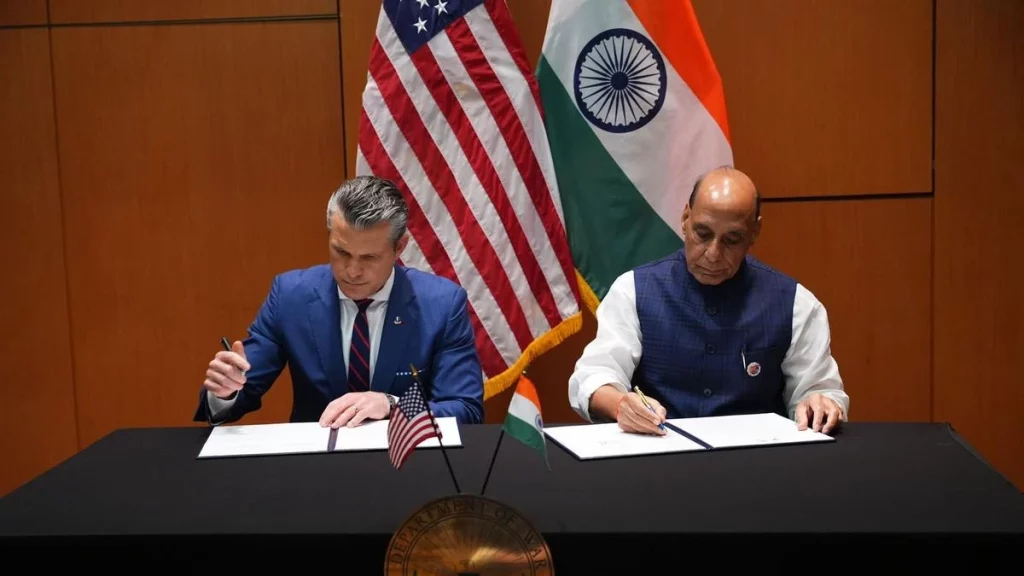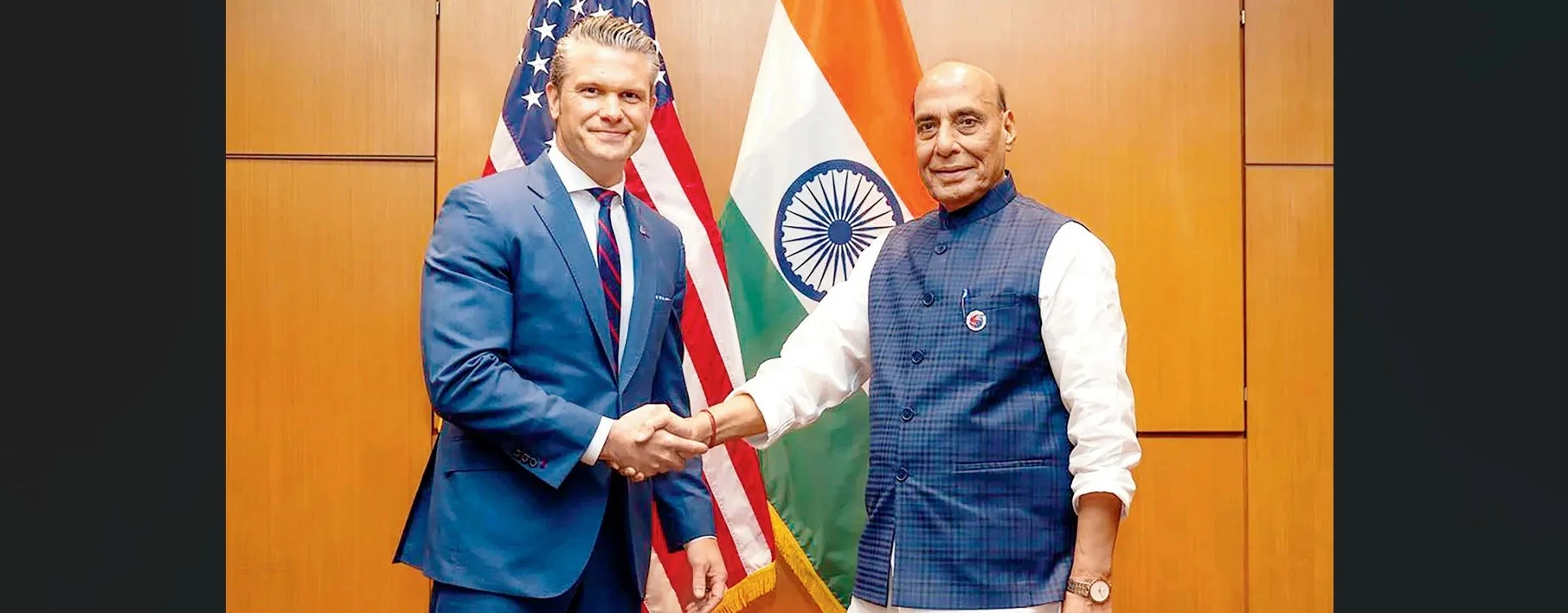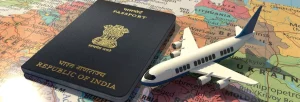(November 7, 2025) The recent pact between India and the US to expand defence cooperation over the next 10 years is set to be a game changer for the Indian Armed Forces, the world’s second-largest military force. If all goes as planned, India can expect a major technological upgrade, modernisation of its defence forces, and stronger defence-industrial partnerships, all of which will enhance India’s regional role in the years ahead.
Coming just months after Operation Sindoor, the timing of this pact has raised eyebrows among India’s neighbours. While the Narendra Modi-led NDA government remains optimistic, the agreement comes at a time when the two nations are also grappling with trade tensions after US President Donald Trump imposed 50 percent tariffs on Indian goods, including a 25 percent penalty for buying Russian oil and arms.

Defence Minister Rajnath Singh and US Defence Secretary Pete Hegseth during the signing of the defence pact
The pact: a new decade of cooperation
The agreement was announced after a meeting between Defence Minister Rajnath Singh and US Defence Secretary Pete Hegseth in Kuala Lumpur. Hegseth said on X that the pact will enhance “coordination, information sharing, and tech cooperation” and advance “regional stability and deterrence.” “It is a signal of our growing strategic convergence and will herald a new decade of partnership,” Rajnath Singh said in a post on X. “Our partnership is critical for ensuring a free, open and rules-based Indo-Pacific region.”
A strategic step for the Indo-Pacific
“The pact adds to the strategic architecture of the Indo-Pacific: stronger India-US military ties contribute to deterrence and balance,” says Colonel Dr. Saji Abraham, Professor at Karunya University, Coimbatore. He notes that the agreement could spur multilateral cooperation involving Australia, Japan, and ASEAN, and reshape how regional powers engage in the Indo-Pacific.
What it means for India
Speaking to Global Indian, Col. Abraham says the pact gives India a stable, long-term roadmap with a major power partner. “This can help in modernising defence forces, upgrading technology, and forging defence-industrial partnerships.” He adds that while the pact supports India’s strategic autonomy, it also signals deeper alignment with the US strategy in the Indo-Pacific, strengthening India’s status as a key player in regional security. “It potentially helps India diversify away from over-reliance on one supplier (Russia) by deepening engagement with the US and accessing advanced tech.”
What it means for the US
For the US, Col. Abraham says, the deal reinforces Washington’s commitment to India as a key Indo-Pacific partner, particularly in countering China’s growing influence. “It helps the US achieve interoperability with a large Asian power, enhance joint exercises and operations, and open defence industrial and co-production opportunities in India.” He adds that a long-term framework brings predictability, a key benefit for US defence firms and strategic planning.

Photo Credit: US Department of War
Strengthening defence ties
India and the US have been steadily ramping up their defence cooperation. During Prime Minister Modi’s February visit to Washington, Trump had said the US would increase military equipment sales to India by billions of dollars, paving the way for potential F-35 stealth warplane sales. While Russia remains a major supplier, its share of Indian defence imports has declined as New Delhi seeks diversification and domestic capacity building. India has also shown willingness to boost energy and defence purchases from the US.
Key features of the pact
The 10-year framework will guide policy direction across the full spectrum of defence ties, focusing on enhanced coordination, intelligence sharing, and technology collaboration. Col. Abraham says the pact signals the seriousness of India-US alignment, even amid trade and tariff friction. He expects bigger and more sophisticated drills — air, land, and sea — between Indian and US forces. Given Indo-Pacific competition, emphasis is likely on undersea warfare, anti-submarine operations, and unmanned vehicle systems.
Greater interoperability and technology cooperation
India’s equipment, training, and doctrines may become more aligned with US and Western standards. “Logistics agreements and access to each other’s bases, ports, and facilities may deepen,” says Col. Abraham. The pact also identifies technology cooperation as a key pillar, paving the way for joint development of advanced systems in areas like space, cyber, missile defence, and unmanned platforms. It could also lead to manufacturing of US-origin systems in India, aligned with the Make in India initiative, and regulatory streamlining to enable faster tech transfer.
Maritime, manufacturing and space collaboration
Col. Abraham sees better coordination in maritime domain awareness as another key area. “There is potential for increased intelligence link-ups for Indo-Pacific sea lane security, counterterrorism, and maritime crime.” He adds that US firms could establish manufacturing bases in India, while Indian firms expand into dual-use and export sectors, boosting the local defence industry. He is also optimistic about collaboration in space and cyber warfare domains. “The pact can also see cyber and electronic warfare cooperation — building resilience, shared training, and common exercises in non-traditional warfare areas.”

Rajnath Singh and Pete Hegseth
Caveats and challenges
While upbeat, Col. Abraham cautions that this is a framework agreement, and implementation will take time. “It sets direction, but detailed steps like procurement, co-production deals, and regulatory changes will follow gradually.” He notes India’s continued emphasis on strategic autonomy, balancing ties with Russia and China, even as it strengthens partnership with the US. On the industrial side, challenges include technology transfer restrictions, IP and supply-chain issues, offset obligations, and costs. “Progress depends on domestic politics, budgeting, and procurement cycles in India as well as US export controls and regional reactions.”
The bottom line
Col. Abraham concludes that the 10-year pact marks a significant upgrade in India-US defence cooperation. “For India, it delivers a long-term roadmap to modernise, diversify, and deepen its defence-industrial base. For the US, it secures a key partnership in a region of strategic importance.” In practice, the next decade may see more joint exercises, deeper tech co-development, stronger interoperability, and a more prominent Indian role in regional security. “The real test will be how quickly tangible outcomes like co-produced systems, integrated logistics support, major joint operations materialise,” he adds.
ALSO READ: India-UK sign a game-changing FTA in a win-win for both nations



